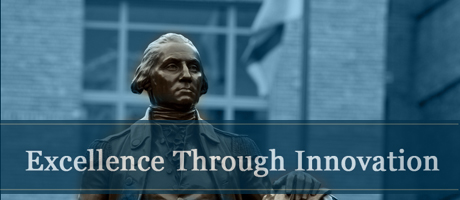Six GW students have been named to the University’s new innovation task force launched by President Steven Knapp earlier this fall.
The innovation task force is composed of a steering committee, chaired by Associate Vice President for Academic Affairs Jeffrey Lenn, and two working groups: one focusing on business processes and the other on academic innovation. Each group has one undergraduate student and one graduate student representative, who will provide a student perspective and serve as a connection to the body of current students.
“We wanted to involve a major stakeholder group, in this case two stakeholder groups—undergraduate and graduate students,” Dr. Lenn says. “All committee members will suggest areas that need to be explored for greater effectiveness or efficiency, do in-depth analyses of these areas; make recommendations about innovative practices; and help to develop implementation plans for bringing about innovative change in specific areas in the future.”
The three undergraduate students, appointed by Student Association President Julie Bindelglass, are:
- Brendan Curran, sophomore, business with a concentration in finance (Business Processes Committee)
- Sohan Gupte, sophomore, international affairs and political science (Learning/ Teaching Committee), and
- Will Rone, senior, mechanical engineering (Steering Committee).
The graduate student representatives are:
- Chris Brooks, second-year student, political management (Business Processes Committee),
- Alyscia Eisen, second-year student, business administration (Steering Committee), and
- Gina Fernandes, second-year student, higher education administration, (Learning/Teaching Committee)
“I think it’s important for all students to get involved in the innovation task force because whatever decisions are made will drastically affect our experience here,” Ms. Bindelglass says. “Any opportunity we have would be a terrible thing to waste.”
The innovation initiative, as outlined by President Knapp in October, calls for GW to increase its investment in learning and research priorities over the next five years by $60 million per year, the equivalent of what GW currently spends from its endowment income each year.
Dr. Knapp’s three-pronged plan includes raising new funds from philanthropic sources; increasing the productivity of GW’s research and instructional programs; and discovering savings in GW’s business processes that can be reinvested in the University’s faculty, students and academic initiatives.
The task force is encouraging members of the GW community to submit their own ideas of how GW can meet the goals of the innovation initiative. The task force hopes this process will be interactive, and it encourages participation from and discussion among all GW community members.
The task force’s charge is to solicit feedback about GW’s strengths as an institution and how GW can improve in academic and business operations areas. It is seeking creative ideas that focus on three key criteria:
- Effectiveness – will the idea ensure that a service or function is enhanced to better meet GW goals and objectives?
- Efficiency – will the proposal help better organize, manage and utilize GW resources?
- Innovation – will the suggestion help GW operate in a truly new way?
Visit http://innovation.gwu.edu to access an electronic form to submit your ideas and to read more about the innovation initiative.


